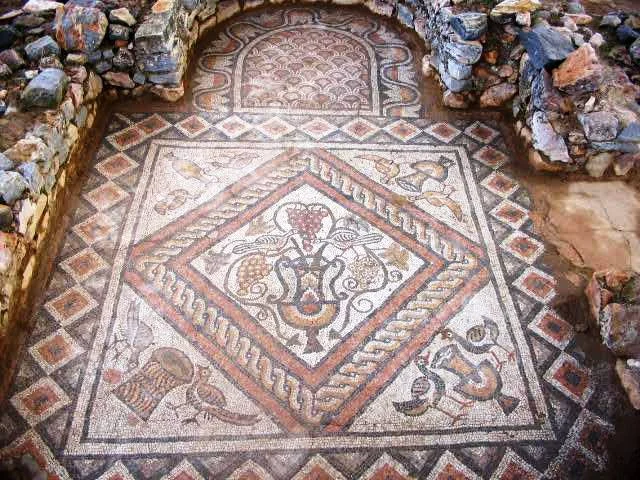- Lin Ancient Mosaics date back to the 6th century AD, reflecting early Christian artistry in Albania .
- The mosaics showcase vibrant geometric, floral, and figurative motifs, exemplifying Byzantine craftsmanship.
- Located on a scenic peninsula near Lake Ohrid, their discovery has significantly enriched Albanian archaeological history.
- Preservation efforts focus on combating environmental challenges, ensuring these mosaics endure for future generations.
- They remain vital symbols of Albania’s Christian heritage and cultural identity, attracting tourists and scholars alike.
Table of contents
- Historical Background of Lin Ancient Mosaics: Origins and Context
- Artistic and Architectural Features: A Celebration of Craftsmanship
- Location and Discovery: Unveiling Hidden Gems
- Cultural and Historical Significance in Albania
- Preservation and Current Condition
- Conclusion: Embracing Albania’s Mosaic Legacy
Historical Background of Lin Ancient Mosaics: Origins and Context
Origins: A Journey to the 6th Century AD
The **Lin Ancient Mosaics** originate from the 6th century AD, a pivotal time marked by the transition from Roman to Byzantine dominance. These mosaics were likely part of an early Christian basilica or church, highlighting the presence of a thriving religious community in Lin. Their intricate designs embody a fusion of faith and artistry, serving as both decorative elements and spiritual narratives. This era reflects a period where religious expression was deeply embedded in visual art, producing treasures that continue to fascinate modern viewers. Learn more about this period at Harvard’s Roman history resources.
Time Period: A Theatre of Change
The 6th century was a time of significant upheaval and cultural evolution in the Balkans. As the Roman Empire waned, the Byzantine Empire expanded its reach, influencing local art and religious practices. The construction of churches and basilicas fostered in the creation of stunning mosaics, which served both liturgical and decorative purposes. The **Lin Ancient Mosaics** stand as testament to this vibrant period of religious devotion and artistic innovation, echoing the vital role of Christianity in shaping regional identity. Further insights can be found at archaeology.org.
Cultural and Historical Setting: A Nexus of Civilizations
The Lake Ohrid region is a melting pot of civilizations — Illyrian, Roman, Slavic, and Byzantine. Its strategic position made it a hub of cultural exchange and religious activity. The mosaics at Lin are embedded within this rich tapestry, representing a localized yet interconnected religious and artistic tradition. These relics shed light on Albania’s role as a crossroads of civilizations, emphasizing its historical importance in shaping regional history. Discover more about the area’s history at ucb.org.
Artistic and Architectural Features: A Celebration of Craftsmanship
Style and Craftsmanship: Byzantine Brilliance
The mosaics exemplify Byzantine artistic excellence, with vibrant colors and detailed patterns. They feature geometric shapes, floral motifs, as well as depictions of animals and human figures. These designs served not only decorative functions but also conveyed spiritual symbolism, often illustrating biblical stories or religious themes. The shimmering colors and meticulous composition make these mosaics a visual feast, encapsulating the divine and earthly in a single frame. Explore Byzantine art at the Metropolitan Museum of Art.
Materials and Techniques: Tesserae Tapestry
Crafted from tiny tesserae—small pieces of colored stone or glass—the mosaics were painstakingly assembled by skilled artisans. The meticulous arrangement of tesserae created detailed imagery and intricate patterns that have endured centuries. The use of durable materials ensured longevity, while the precise techniques reflect a high level of craftsmanship typical of Byzantine mosaics. For more on tesserae techniques, visit Mosaic Art Source.
Unique Design Elements: Mystery in Motifs
The mosaics feature motifs and symbols whose meanings remain partially enigmatic. Some iconography may relate to local traditions or specific Christian symbolism. Researchers continue to investigate these elements, uncovering potential messages hidden within the intricate patterns. Each motif offers clues into the spiritual and cultural mindset of the era, inviting further scholarly exploration. Dive into hidden symbols at JSTOR.
Location and Discovery: Unveiling Hidden Gems
Location: Nature’s Embrace
Situated on a scenic peninsula on Lake Ohrid’s western shore, the **Lin Ancient Mosaics** enjoy a breathtaking natural setting. Lake Ohrid, one of Europe’s oldest and deepest lakes, provides a tranquil backdrop that enhances the site’s aesthetic appeal. The mosaics are perched on a hill overlooking the lake, offering visitors a harmonious blend of history and landscape. The site’s beauty and serenity deepen visitors’ appreciation of its cultural significance. Learn more at UNESCO World Heritage.
Discovery and Excavation: Rewriting Histories
The mosaics were rediscovered during mid-20th-century excavations, revealing a buried relic of early Christian architecture. The finds transformed Albanian archaeology by exposing a rich layer of religious and artistic history. Excavations uncovered the remains of a basilica adorned with these mosaics, offering a rare glimpse into the past. This discovery sparked renewed scholarly interest and expanded knowledge of early Christian communities in the region. Details are available at archaeological.org.
Researchers and Historians: Guardians of the Past
Many experts have contributed to studying the **Lin Mosaics**, analyzing their themes, techniques, and significance. Ongoing research helps understand their context within Byzantine art and Albanian history. Preservation efforts also benefit from the dedication of archaeologists, conservators, and historians, who work tirelessly to protect this cultural treasure. Their work ensures that future generations can continue to marvel at these ancient masterpieces. More about ongoing research can be found at historical-research.org.
Cultural and Historical Significance in Albania: A Tapestry of Influence
Role and Importance: Custodians of Heritage
The **Lin Ancient Mosaics** serve as vital symbols of Albania’s Christian and cultural heritage. They symbolize the region’s early religious roots and artistic achievement. As one of Albania’s most important archaeological sites, they attract visitors, scholars, and cultural preservation efforts alike. These mosaics embody a historical legacy that continues to inspire national pride and identity. Read more about Albania’s heritage at albanianheritage.org.
Reflection of Art, Religion, and Society: A Lens to the Past
The mosaics reveal much about the art, faith, and social fabric of early Christian communities in the region. Their detailed motifs and iconography illustrate religious stories, societal values, and cultural influences of their time. These silent witnesses provide insights into the spiritual life and artistic preferences of a bygone era, offering a window into history’s complexities. For deeper analysis, visit artsandculture.google.com.
Influence on Modern Culture and Tourism: Echoes Through Time
Today, the mosaics are celebrated attractions, featured in museums and cultural programs across Albania. They attract tourists keen to explore Albania’s ancient past and inspire contemporary artists. The site’s cultural significance fuels tourism, supporting local economies and fostering pride in national heritage. Their enduring legacy underscores the importance of preserving history amidst modern development.
Preservation and Current Condition: Guardianship of a Legacy
Current State: Preservation Endeavors
Active conservation projects aim to protect the mosaics from environmental damage, especially given their lakeside location. These efforts involve monitoring, cleaning, and restoring the mosaics, often with international collaboration. Proper preservation ensures that these treasures remain accessible and intact for future generations to study and enjoy. Initiatives follow standards set by organizations like the World Monuments Fund.
Challenges in Conservation: Trials in Time
The site faces environmental challenges such as humidity, humidity fluctuations, and natural erosion. Vandalism and theft also pose risks, requiring vigilant security measures. Securing sustainable funding and employing expert conservation techniques are essential for ongoing protection. Tackling these issues is crucial to maintaining the mosaics’ integrity amid natural and human threats. Details on conservation challenges can be explored at encounteralbania.org.
Visitor Access: A Window to the Past
The site welcomes visitors through guided tours, which enhance understanding and appreciation. Respectful engagement and adherence to preservation guidelines help sustain the mosaics’ condition. Educational programs and signage further enrich visitor experience, ensuring the site remains a living link to Albania’s past while fostering cultural tourism.
Conclusion: Embracing Albania’s Mosaic Legacy
The Lin Ancient Mosaics encapsulate a period of artistic brilliance and religious fervor, serving as enduring symbols of Albania’s cultural identity. Their preserved beauty offers insight into early Christian life and Byzantine artistry, inviting curiosity and respect. By protecting and promoting these mosaics, we honor a rich historical tapestry that continues to inspire. We encourage you to explore further, discovering Albania’s treasures and marveling at their timeless significance. Let these mosaics be a beacon of cultural appreciation and historical preservation for generations to come.


0 Comment